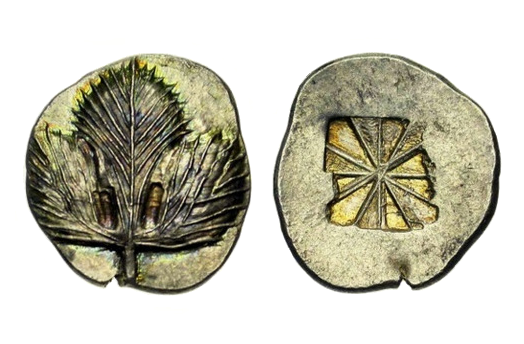
about ancient nomos
Ancient Nomos Art is a museum of galleries exhibiting ancient coins and ancient mint maps. The coin gallery displays the diverse art and history of hand-crafted ancient Greek, Roman, Byzantine, Persian and Medieval coinage. The ancient mints mapping gallery features Greek, Roman, Byzantine, Asia Minor and Medieval mint city regions and territories. Visitor's are welcome to explore, study and enjoy Ancient Nomos Art.

Greek, Selinos – 540 BC
Selinos, Sicily
From Ancient Galleries

Obverse: 3 part Selinon (Celery) leaf with short stem, central petiole and veins.
Reverse: Incuse square divided into 12 equal triangle sections by six vector lines.
LEGEND SYMBOLS
Obv: Retrograde Selinon (Celery) leaf with short stem. Rev. Incuse square divided into 12 equal triangle sections with alternating granulated areas, scribed by 6 vector lines with common center.
The Magna Grecia ancient city of Selinos is located along the southwestern coastal area of Sicily in the province of Trapini, Italy. The ancient acropolian city is located near the mouth of the Selinos River and just a few miles west of Hypsas. Historians believe this city was settled in the middle 7th century BC by the Dorian Greek colonists from Megara. About a century later, the Dorian colonies begin the coinage of Selinus and that of Magna Grecia proper. This primarily agricultural city was situated in a very fertile plain flanked by the fresh water supplied by the river. Selinos is said to derive its name from the wild Selinon or wild Celery (Apium Grareolens or variety of wild Parsley) which grew bountifully along the river banks during the ancient Greek settlement of Sicily. The Selinuntines undoubtedly adopted the Selinon leaf as the symbol of their city, much the way the ear of barley came to signify Metapontion (see Metapontion nomos), for its agricultural importance, perhaps medicinal value, and mythological associations. Ancient historians have suggested a large golden representation of the leaf was found in the Temple of Apollo at Delphi (Plut.l.c.). The Selinon emblem on the magnificent coin above became the cities standard nomos coin design by 540 BC. The incuse square reverse has mystified scholars since the coins discovery. The square has been divided by six diagonal lines forming twelve triangle areas, each alternating with smooth and textured areas. Some suggest each angle section signifies the monetary value of 12 obolos to this didrachm. Others suggest the enigmatic vectors are a sacred axis-mundi symbol or perhaps even a geometric abstraction of plant anatomy. Selinos prospered for nearly 250 years before finally being invaded by her rival Trojan neighbor of Segesta in 409 BC. Selinos was slowly rebuilt, but was ultimately destroyed by Carthage in 250 BC, leaving in ruins several magnificent Doric temples.
DOCUMENTATION
Value: Didrachm. Metal: AR Silver. Weight: 8.83 grams. Mint: Sicily, Selinos. Date: 540-510 BC.
Attribution: Arnold-Biucchi, ANS MN (1988) 33, Plate 1, 10 & 12; SNG ANS 676; SNG Lloyd 1204; NFA 1991, 19; NGSA 8, 18 (same dies); Weber, Plate 58, 1528.
Legend, Documentation and Attribution
